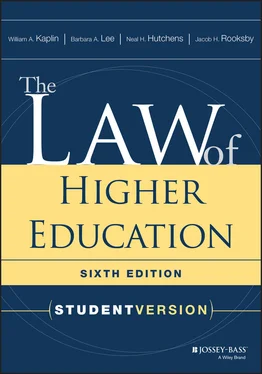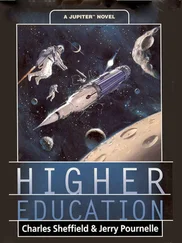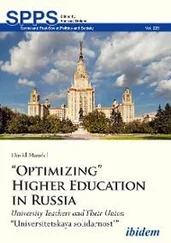Two 1971 cases decided by the Supreme Court provide the foundation for the modern law on government support for church-related schools. Lemon v. Kurtzman , 403 U.S. 602 (1971), invalidated two state programs providing aid for church-related elementary and secondary schools. Tilton v. Richardson , 403 U.S. 672 (1971), held constitutional a federal aid program providing construction grants to higher education institutions, including those that are church-related. In deciding the cases, the Court developed a three-pronged test for determining when a government support program passes muster under the establishment clause:
First, the statute must have a secular legislative purpose; second, its principal or primary effect must be one that neither advances nor inhibits religion…; finally, the statute must not foster “an excessive government entanglement with religion” [403 U.S. at 612–13, quoting Walz v. Tax Commission , 397 U.S. 664, 674 (1970)].
All three prongs have proved to be very difficult to apply in particular cases.
In Agostini v. Felton , 521 U.S. 203 (1997), the U.S. Supreme Court refined the three-prong Lemon test, specifically affirming that the first prong (purpose) has become a significant part of the test and determining that the second prong (effect) and third prong (entanglement) have, in essence, become combined into a single broad inquiry into effect. (See 521 U.S. at 222, 232–33.) And in Mitchell v. Helms , 530 U.S. 793 (2000), four Justices in a plurality opinionand two Justices in a concurring opinioncriticized a “pervasively sectarian” test that had been developed in Hunt v. McNair, 413 U.S. 734 (1973), as part of the effect prong of Lemon . These Justices also gave much stronger emphasis to the neutrality principle that is a foundation of establishment clause analysis.
Four U.S. Supreme Court cases have applied the complex Lemon test to religious postsecondary institutions. In each case the aid program passed the test. In Tilton v. Richardson (above), the Court approved the federal construction grant program, and the grants to the particular colleges involved in that case, by a narrow 5-4 vote. In Hunt v. McNair (above), the Court, by a 6-3 vote, sustained the issuance of revenue bonds on behalf of a religious college, under a South Carolina program designed to help private nonprofit colleges finance construction projects. Applying the “primary effect” test as explained above, the Court determined that the college receiving the bond proceeds was not “pervasively sectarian” (413 U.S. at 743) and would not use the financed facilities for specifically religious activities. In Roemer v. Board of Public Works , 426 U.S. 736 (1976), by a 5-4 vote, the Court upheld the award of annual support grants to four Catholic colleges under a Maryland grant program for private postsecondary institutions. As in Hunt , the Court majority (in a plurality opinion and a concurring opinion) determined that the colleges at issue were not “pervasively sectarian” (426 U.S. at 752, 755) and that, had they been so, the establishment clause might have prohibited the state from awarding the grants. And in the fourth case, Witters v. Washington Department of Services for the Blind , 474 U.S. 481 (1986), the Court rejected an establishment clause challenge to a state vocational rehabilitation program for the blind that provided assistance directly to a student enrolled in a religious ministry program at a private Christian college.
Distinguishing between institution-based aid and student-based aid, the unanimous Court concluded that the aid plan did not violate the second prong of the Lemon test, since any state payments that were ultimately channeled to the educational institution were based solely on the “genuinely independent and private choices of the aid recipients.” Taken together, these U.S. Supreme Court cases suggest that a wide range of postsecondary support programs can be devised compatibly with the establishment clause and that a wide range of church-related institutions can be eligible to receive government support.
Of the four Supreme Court cases, only Witters focuses on student-based aid. Its distinction between institutional-based aid (as in the other three Supreme Court cases) and student-based aid has become a critical component of establishment clause analysis. In a later case, Zelman v. Simmons-Harris , 536 U.S. 639 (2002) (an elementary/secondary education case), the Court broadly affirmed the vitality of this distinction and its role in upholding government aid programs that benefit religious schools. Of the other three Supreme Court cases— Tilton , Hunt , and Roemer — Roemer is the most revealing, at least as to its facts. There the Court refused to find that the grants given a group of Catholic colleges constituted support for religion—even though the funds were granted annually and could be put to a wide range of uses, and even though the schools had church representatives on their governing boards, employed Roman Catholic chaplains, held Roman Catholic religious exercises, required students to take religion or theology classes taught primarily by Roman Catholic clerics, made some hiring decisions for theology departments partly on the basis of religious considerations, and began some classes with prayers. Roemer , however, has been criticized in later U.S. Supreme Court cases, especially for its “pervasively sectarian” reasoning. (See e.g., Mitchell v. Helms , 530 U.S. 793 (2000) [introducing a “neutrality-plus” test].) 9
Post- Roemer cases in the lower courts have frequently involved the state's issuance of revenue bonds to finance the building projects of private religious institutions. The issues usually implicate the federal Constitution's establishment clause and the Roemer line of cases discussed above, and may also implicate the state constitution's religion clauses. 10
When issues arise concerning government support for religious institutions, or their students or faculty members, the federal Constitution (as in the cases above) is not the only source of law that may apply. In some states, for instance, the state constitution will also play an important role. A line of cases concerning various student aid programs of the state of Washington provides an instructive example of the role of state constitutions and the complex interrelationships between the federal establishment and free exercise clausesand parallel provisions in state constitutions. The first case in the line is the U.S. Supreme Court's decision in Witters v. Washington Department of Services for the Blind ( Witters I ), discussed above. There the Court remandedthe case to the Supreme Court of Washington (whose decision the U.S. Supreme Court had reversed), observing that the state court was free to consider the “far stricter” church-state provision of the state constitution. On remand, the state court concluded that the state constitutional provision—prohibiting use of public moneys to pay for any religious instruction—precluded the grant of state funds to the student enrolled in the religious ministry program ( Witters v. State Commission for the Blind , 771 P.2d 1119 (Wash. 1989) [hereinafter, Witters II ]). First the court held that providing vocational rehabilitation funds to the student would violate the state constitution because the funds would pay for “a religious course of study at a religious school, with a religious career as [the student's] goal” (771 P.2d at 1121). Distinguishing the establishment clause of the U.S. Constitution from the state constitution's provision, the court noted that the latter provision “prohibits not only the appropriation of public money for religious instruction, but also the application of public funds to religious instruction” (771 P.2d at 1122). Then the court held that the student's federal constitutional right to free exercise of religion was not infringed by denial of the funds, because he is “not being asked to violate any tenet of his religious beliefs nor is he being denied benefits ‘because of conduct mandated by religious belief’” (771 P.2d at 1123). Third, the court held that denial of the funds did not violate the student's equal protection rights under the Fourteenth Amendment, because the state has a “compelling interest in maintaining the strict separation of church and state set forth” in its constitution, and the student's “individual interest in receiving a religious education must…give way to the state's greater need to uphold its constitution” (771 P.2d at 1123).
Читать дальше












